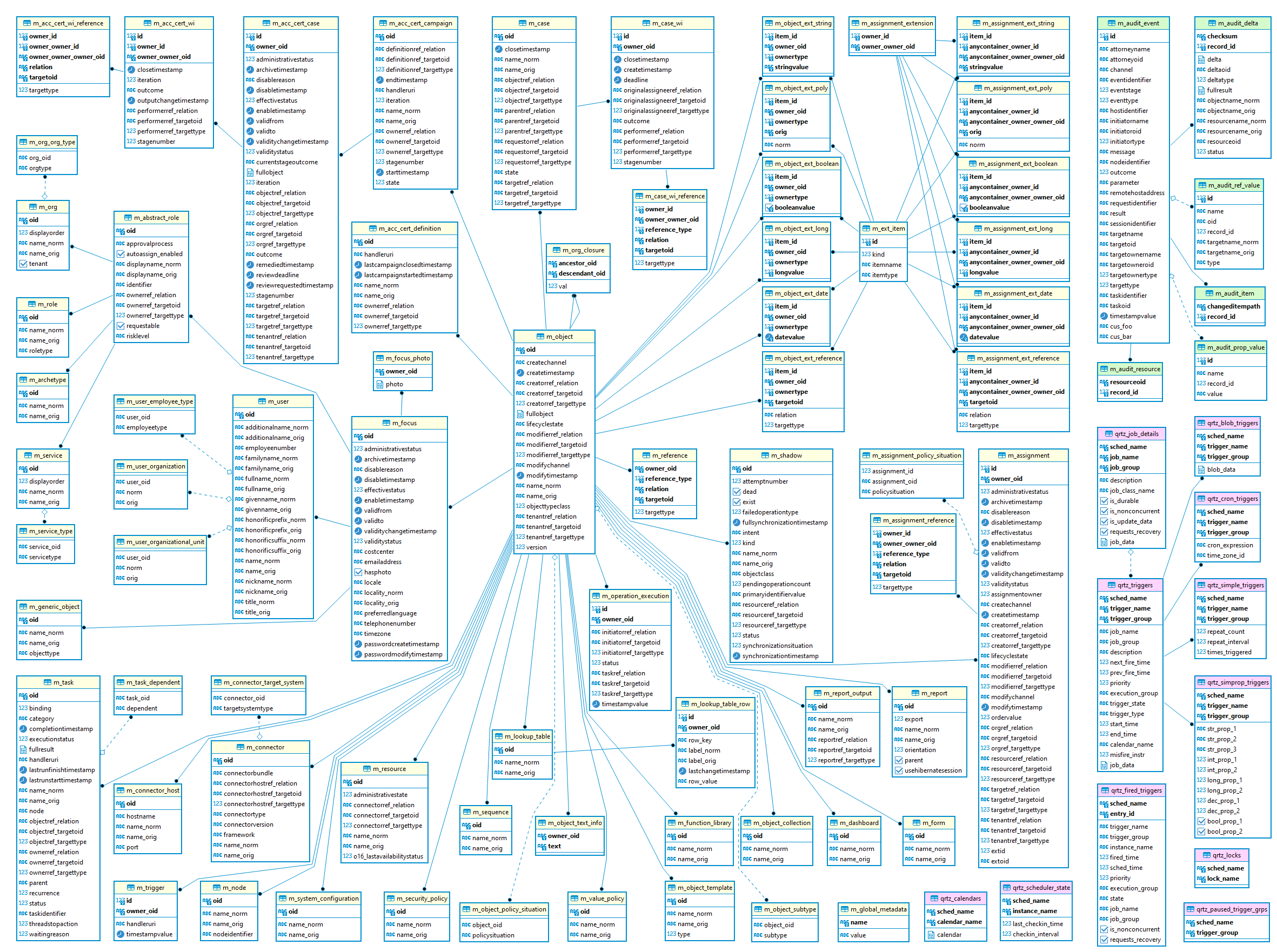<configuration>
<midpoint>
<repository>
<repositoryServiceFactoryClass>com.evolveum.midpoint.repo.sql.SqlRepositoryFactory</repositoryServiceFactoryClass>
<database>sqlserver</database>
<jdbcUsername>midpoint</jdbcUsername>
<jdbcPassword>password</jdbcPassword>
<jdbcUrl>jdbc:sqlserver://localhost:1433;database=midpoint</jdbcUrl>
</repository>
</midpoint>
</configuration>Generic SQL Repository Implementation
|
Deprecated
This functionality is deprecated since version 4.4.
The functionality is still supported and maintained, but it will no longer be extended.
The plan is to remove this functionality sooner or later.
Users of this functionality are strongly encouraged to stop using this functionality and migrate to a newer equivalent.
|
| This page discusses deprecated repository implementation that was replaced with Native PostgreSQL repository. |
SQL repository implements both repository and audit API. It facilitates Hibernate 6.5 as persistence framework, and for connection pooling HikariCP.
Audit records are stored synchronously and implementation currently shares connection pool with main repository. There are few planned improvements for audit, see MID-4745.
Configuration
Repository component configuration is placed in main config.xml file in midpoint.home folder.
For more complex configurations using different DB vendors see Repository Configuration.
DB tables, structures
Our data objects defined in common-3.xsd schema which are managed by SQL repository are quite complex.
They are stored in m_object table in fullObject column as blobs.
Parts of these objects are stored in related tables for better searching.
The following picture shows DB schema for version 4.2 (ER diagram extracted with DBeaver from PostgreSQL):

Objects from main schema are designated with yellow title background, audit is green and Quartz tables (scheduler, or jobs store) are purple. Both Quartz and audit can be placed in different databases using different JDBC configurations.
General
PrismObject represented as XML objects contain one natural primary key - oid attribute.
Some objects also contain PrismContainers which use id as container identifier (assignments, inducements, triggers, etc.). Identifiers for objects and containers are generated in midPoint.
Object references introduced in XSD schema are transformed to entities with weak reference which means reference doesn’t use foreign key to achieve full consistency across midPoint repository.
This will simplify work with objects during import or delete as it’s not necessary to correctly sort objects before making any changes.
To further improve hibernate performance we’ve introduced EntityState interface.
This interface is used within most entities.
Developer knows in most cases whether entity is transient or detached, therefore hibernate doesn’t need to do any checks (we’ll get rid of many unnecessary select queries).
Storing xsd:any attributes
xsd:any container can be found in:
-
ObjectType - extension (and subclasses)
-
ShadowType - attributes
-
AssignmentType - extension
Schema for extension containers is static for first and third case.
ShadowType attributes use dynamic schema which depends on defined resources.
Extension container can contain elements of different types.
SQL repository supports String, Long, Date, Clob, ObjectReferenceType and PolyStringType.
All elements are aggregated to these types (tables).
-
Long, Integer, Short → Long
-
Date (Gregorian calendar) → Date
-
String, Double, Float → String
-
ObjectReferenceType and PolyString types are handled via custom tables
-
Everything else goes to Clob
Long, Date and String values are indexed, clob is not indexed. Real types for aggregated types are saved as QName values. Aggregation translation for xsd:any values is provided by RAnyConverter. Repository uses dictionary implementation to store/load different properties, see ExtItemDictionary. New items are added to dictionary in transaction other than current add/modify operation is in. In such case parent transaction is restarted.
Audit structures
Audit tables uses IDENTITY columns (autoincrement).
Transactions, locking failover
SQL repository uses simple transactions which last during single operation (e.g. add/modify/delete/search).
When transaction fails because of locking (table lock timeout, record timeout), SQL repository tries to repeat operation for number SqlRepositoryServiceImpl#RESTART_LIMIT times.
As this implementation supports databases from multiple vendors, transaction and locking configuration is different for each vendor.
Default configurations are defined in SqlRepositoryConfiguration.
Querying
See the relevant section in Query API documentation for details about what is or is not supported from our Query API in the repository.
Query processing is implemented in QueryInterpreter which uses QueryDefinitionRegistry
to translate queried value name to the real hibernate entity property name.
Tests
Most tests are located in module repo-sql-impl-test.
Overall code description
todo
-
SqlRepositoryBeanConfig - spring wiring and initialization
-
SqlRepositoryConfiguration - sql repository configuration, handles config.xml and such
-
DataSourceFactory - connection pool initialisation and configuration